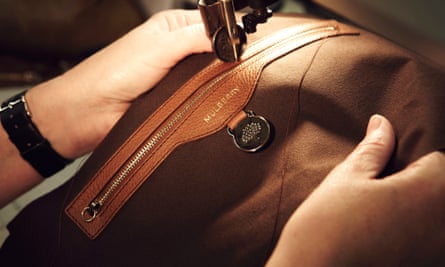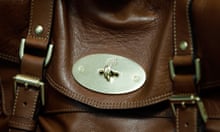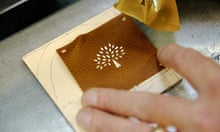Deep in the Somerset countryside Mulberry is working hard to rekindle the popularity of a fashion brand whose allure has suffered in recent years, ever since it made a reckless leap upmarket.
Most of Mulberry’s trademark leather handbags are produced in south-west England, including the Cara Delevingne collection of “town to country” and “train to plane” bags designed in collaboration with the 22-year-old British model and featuring her favourite camouflage print.
About 60% of its products are made in Somerset factories: there’s the Rookery, in the village of Chilcompton in a fold of the Mendip hills, and the Willows, which opened last year about an hour down the road in Bridgwater.
But the business is still recovering from the departure of chief executive Bruno Guillon, whose two-year reign ended in March. It was Guillon’s ill-judged attempt to reposition the brand at the top end of the luxury bag market, as a rival to the likes of Gucci and Prada, that badly damaged its standing.
Once-loyal customers felt alienated, unable or unwilling to spend £1,000 or more on the bags produced under Guillon; Mulberry’s traditional ranges cost half that price.
Former chief executive Godfrey Davis is now back at the helm as executive director with a mission to win back those core customers. He moved swiftly to reinforce Mulberry’s commitment to its more affordable ranges, but the scale of the challenge is clear: last month Mulberry issued its fourth profit warning this year and is still without a creative director. The highly regarded Emma Hill resigned unexpectedly in June last year amid speculation that she had clashed with Guillon over the direction of the brand.
Central to Mulberry’s hoped-for comeback are not just its British customers, but also its British operations. On the factory floor at the Rookery, group production manager Nick Speed says the ups and downs of the business, as well as seasonal changes tend not to affect its UK production lines, because the British manufacturing operation is given priority over factories overseas. Over the past three years, the Rookery has been extended to increase capacity, and the Willows was opened as Mulberry brought its remaining UK production back in-house.
“The UK is very important as a manufacturing base,” says Speed. “We’re a UK company so we do focus on the UK factories first. When necessary we draw work back from Asia into Europe, and from Europe into the UK. This is always a priority. We’ve only got two Mulberry-owned factories – the Rookery and the Willows – and we always make sure that they are filled first. So our workloads tend to be pretty constant.”

Workers at the Rookery are busy making bags for the spring/summer 2015 collection, while up in development, designs for next autumn/winter are being worked on.
In the leather store, shelves are piled high with sheets of the material. Between 130,000 and 150,000 square feet of leather is cut at the Rookery every month. Cowhide and goatskin are used to make Mulberry goods, as well as ostrich leather and alligator skins. A more surprising sight on the shelves is the stack of boxes of baby wipes: they’re apparently handy for removing minor marks and cleaning workers’ hands.
Mulberry has partnerships with manufacturers in Turkey, Spain, Portugal and China, but Speed is keen to highlight the company’s credentials as a British manufacturer. “We feel its the right thing [to manufacture in the UK],” he says. “As a business, for our brand and what we’re trying to create, we’re doing this because it is the right thing. Manufacturing in the UK works.
“There are so many logistical problems with manufacturing abroad and the infrastructure you need in place to manage that. There is a cost difference, but our customers are willing to pay for that ‘made in England’ assurance. We could move it all to Turkey and China and get it made cheaper, but that’s not what we’re about.”
About 95% of the leather used to make Mulberry bags and accessories comes from tanneries in Italy, and is finished and ready to cut by the time it arrives in the UK factories.
Mulberry’s production lines in Somerset are busy but the broader decline in Britain’s postwar manufacturing sector is keenly felt here, both in the factories and in the region itself. The area was a traditional heartland of leather production, partly a legacy of shoemaker Clarks, which still has its head office and design and innovation functions in Somerset, but no longer manufactures in the UK.
“There was a lot of leather industry around this area, but they’ve all gone offshore now,” says Speed. “We’re doing the reverse. Unfortunately that has meant that whereas we used to have tanneries more local to us, they’ve all gone offshore as well. It’s the knock-on effect of manufacturing going away from Britain.
“All those support functions are going away as well. When I first joined the company, we used to get most of our components from the UK – buckles for our bags, for example, came from the Midlands. Now, unfortunately, we have to go to China to buy these things. We’re always looking for suppliers nearer to home but that element of the manufacturing process hasn’t come back yet. I think it will eventually, but at this moment we have to go where we can get the supplies from.”
Production staff at the Rookery are working across 11 production lines. On one line, 15 employees are meticulously working on different aspects of producing Bayswater Buckle handbags. Their target for the day is to make 33 of the items from start to finish. At full capacity, the factory produces up to 1,100 bags a week, with some designs taking longer to make than others.
At the end of the line bags are checked for imperfections and returned to the line for further work if necessary. They are all checked again before being neatly packaged up to be sent on their way to the distribution centre in Shepton Mallet, also in Somerset, from where they will be shipped around the world. But before they make it out of the factory door, a 10% sample will be checked one last time.
“Everything we manufacture is made to order: it has a pre-determined customer. We don’t make anything for stock,” Speed says.
While some specialist manufacturing skills have been lost to the region, Mulberry has the scale to invest in training, partly through its apprenticeship programme. Speed says its skilled workforce is at the heart of Mulberry. “This is handcraft in action. These are highly skilled people and this will never be taken over by a machine, that’s for sure.”
Back at head office, Godfrey Davis will be hoping that it is not just supermodel collaborations but skilled staff in Somerset that can reignite the British love affair with Mulberry.








Comments (…)
Sign in or create your Guardian account to join the discussion